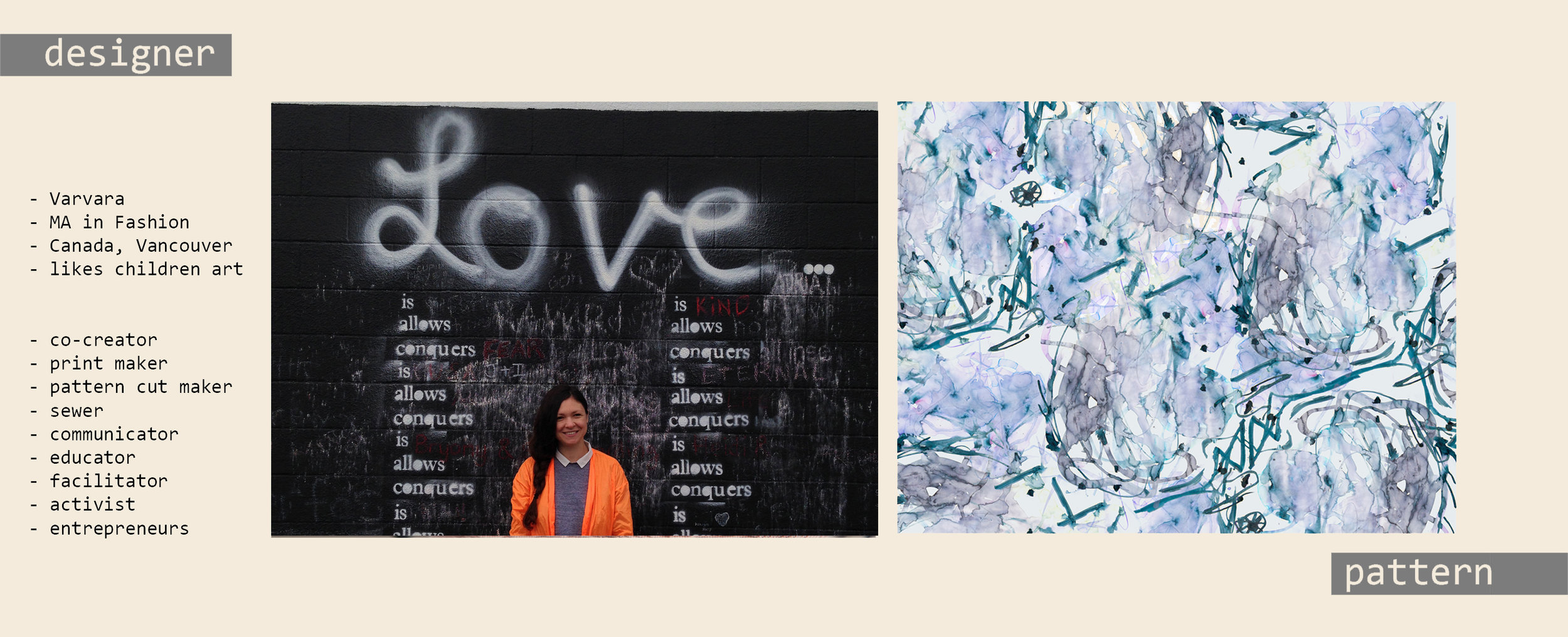Ready-to-Paint: Co-Creation with Little Artists
Ready-to-paint project explores the possibilities of sustainable production and co-creation with the consumer. It aims at creating additional value to provide increased emotional attachment between consumers and products by producing high quality, emotionally valuable, and therefore durable clothing. Altogether, the project targets reducing both preconsumer and postconsumer [1] fabric waste in the fashion industry.
“Stop thinking about art works as objects and start thinking about them as triggers for experiences.”[2]
From years of personal observation, I discovered that art made by children is often valued by families and preserved for the future. Applying this observation to the design practice, I figured that using such artworks for clothing design could add the value to garments. Personally, I also think that children’s drawings can be visually attractive. Based on my experience as clothing/textile designer, however, children’s drawings are also in line with contemporary art trends and can be transformed into professional-looking print patterns. Hence, an idea emerged to produce made-to-order clothes with prints that are co-created with children. Luckily, contemporary digital fabric printing technology allowed me to execute this idea and even to make these clothes with no fabric waste.
As a sustainable design practice, working with children provides an opportunity to address not only the adult consumer but also a younger audience. As Sprenger explains, “A child’s development and learning occur in and are influenced by multiple social and cultural contexts. The brain learns through experience.”[3] I suggest we, the designers, invite children to participate in the design process, make the experience of owning the clothes personal, and provide an opportunity to enjoy both – that is, the process and the outcome. If we want to raise a new generation of consumers who support sustainable development guidelines, we need to involve our children in the process. In fact, they are the next generation. Creating a positive experience in childhood (here, experiences of co-creation, of owning ethically made clothes that have a personal story, and of knowing the origins of your clothes) has the potential to form good habits in the future, and specifically, good consumer habits.
In the project, the consumer is a co-creator, also a co-tester, co-promoter, and co-evaluator. By inviting the consumer to engage in the process, we co-create the value of the product, and as the result fill the garment with potent embodied memories. Technically, the parent sends a digital version of child’s artwork for to be further developed by the designer, permitting a professionally-executed pattern print to be created. This pattern print is then combined digitally with the pattern cut of the garment and labels. A digital fabric printing company then prints it all together; thereafter, the fabric is cut and the garment is assembled by a sewer. This process allows one to produce garments that are made-to-order, with multiple colors used. As a result, the family gets back their unique and sustainable garment, co-created with their child’s artwork.
In this scenario, the designer is the one responsible for the professional realization, the physical and aesthetic qualities of the fabric, and the way the garment is produced. The initial goal is to satisfy the consumer. However, the more meaningful goal is to educate and inspire both the consumer (parents) as well as future generations (children). For these reasons, sustainable production methods were chosen. Additionally, the clothing labels feature the names of the main parties involved in the production of the garment: the artist (child), print designer, cut designer, print company, and fabric supplier and seamstress. Ideally, every design decision in the process should be made with respect towards the user, the business, and toward the environment.
The label both underscores the importance of knowing the origins of your clothes and informs on how the clothes were produced using sustainable production methods. The label that features the name of the co-creator printed twice: visible, on the exterior of the garment, and on the inside.
As a designer I hope to create design objects that are produced with no preconsumer waste and that are loved and preserved from the landfill by the consumer later. I believe that together designers and consumers can change the situation for better –influencing the fashion industry from each end.
Going back to the quotation that opens this essay, imagine what if after “we stop thinking about art works as objects”, we then stop thinking about clothing as objects and start thinking of it as triggers for experiences?
Notes
[1] To know more about the term preconsumer and postconsumer please see Timo Rissanen and Holly McQuillan, Zero waste Fashion Design, (London: Bloomsbury, 2016).
[2] Ascott in Brian Eno, "Miraculous Cures and the canonization of Basquiat" in A Year with Swollen Appendices: Brian Eno’s Diary (London: Faber and Faber, 1996), 369.
[3] Marilee Sprenger, The Developing: Birth to Age Eight (California: Corwin Press, 1949).
Image Attributions
Image 1, Photo: George Kronberg; Cut: Varvara Zhemchuzhnikova
Image 2, Photo: Elisa Mirliton; Artwork: Sophie Mirliton
Image 3, Photo: George Kronberg; Pattern Design: Varvara Zhemchuzhnikova, Sophie Mirliton
Image 4, Photo: Varvara Zhemchuzhnikova; Design: Varvara Zhemchuzhnikova, Sophie Mirliton
Image 5, Photo: Evgeniya Rodionova
Image 6, Design: Varvara Zhemchuzhnikova
Image 7, Photo: Elisa Mirliton









